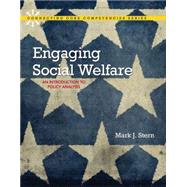NOTE: Used books, rentals, and purchases made outside of Pearson
If purchasing or renting from companies other than Pearson, the access codes for the Enhanced Pearson eText may not be included, may be incorrect, or may be previously redeemed. Check with the seller before completing your purchase.
This access code card provides access to the Enhanced Pearson eText
Examines how social workers can influence policy through practice.
Engaging Social Welfare: An Introduction to Policy Analysis explains the clash between political and economic forces that shape social welfare policy and how social workers can influence policy through their practice. Students will learn how social workers can impact policy in ways that may not feel like policy making, such as reducing the impact of law on their clients, or figuring out a more efficient and effective way to deliver a service. This title provides readers with the knowledge and set of competencies needed to translate the phrase policy practice into meaningful action and the understanding that every social worker is a policymaker.
Connecting Core Competencies Series - This title is part of the Connecting Core Competencies Series, designed to guide students in becoming skilled at the Council on Social Work's core competencies. Each chapter reflects and integrates the latest CSWE competency standards (EPAS). End-of-chapter assessment reinforces this integration.
Improve mastery and retention with the Enhanced Pearson eText
This access code card provides access to the new Enhanced Pearson eText, a rich, interactive learning environment designed to improve student mastery of content. The Enhanced Pearson eText is:
- Engaging. The new interactive, multimedia learning features were developed by the authors and other subject-matter experts to deepen and enrich the learning experience.
- Convenient. Enjoy instant online access from your computer or download the Pearson eText App to read on or offline on your iPad® and Android® tablet.*
- Affordable. Experience the advantages of the Enhanced Pearson eText for 40-65% less than a print bound book.
*The Pearson eText App is available on Google Play and in the App Store. It requires Android OS 3.1-4, a 7” or 10” tablet, or iPad iOS 5.0 or later.








